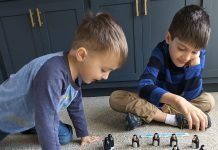Even before our babies are born, we begin talking to them. We read and sing and tell stories as a way to connect with this new little person. We talk about what we’re doing and seeing and thinking. All this language helps our kids build their emotional vocabulary—colors, animals, foods, household items are all part of our daily narration.
We’re more hesitant to teach our kids words for feelings. Maybe because kids seem to be so totally full of emotion and we don’t want to give those gigantic feelings more energy.

UCLA professor of clinical psychiatry and author Dr. Dan Siegel encourages us to talk about our feelings and to teach our kids to do the same. He developed the strategy “name it to tame it” as a way manage overwhelming feelings. When the emotional center of our brain is dysregulated, we are struggling to feel connected to those around us. Feeling connected allows us to soothe this emotional state and move toward problem-solving.
Even more importantly, Siegel says, “Sharing your experience with others can often make even terrifying moments understood and not traumatizing.”
So how do you begin to build an emotional vocabulary with your children?
Start with the four basic feelings: mad, glad, sad and afraid. Then add levels and shades of these emotions to create a richer and more nuanced vocabulary. Model using specific feeling words in your interactions with your kids and your family.
The Mood Meter, developed by Dr. Marc Brackett of the Yale Center for Emotional Intelligence, can be a helpful tool in mapping feelings and setting a course for a more desirable emotional location. The meter defines emotions as having two dimensions—pleasant vs unpleasant and high energy vs low energy.
Remember that all feelings are acceptable but not all expression of feelings are OK. It’s totally OK for kids to feel angry or disappointed. Many times, they have good reasons to feel that way. It’s not OK for kids (or anyone) to be hurtful in expressing these big feelings. Expressing feelings with words not actions is a skill and requires practice for improvement.

Emotions exist. They aren’t bad or good, male or female, appropriate or inappropriate. They simply are. And they are easier to manage when they are known and named.
















